

World War I Centenary: 100 Legacies of the Great War. Sobering Images Show Famous World War I Battle Sites A Century Later. World War 1 in 6 Minutes. World War I in Photos: Aerial Warfare. Making the World "Safe for Democracy": Woodrow Wilson Asks for War. On April 2, 1917, President Woodrow Wilson went before a joint session of Congress to seek a Declaration of War against Germany in order that the world “be made safe for democracy.”
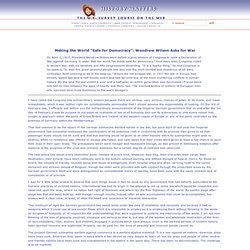
Four days later, Congress voted to declare war, with six senators and fifty congressmen dissenting. “It is a fearful thing,” he told Congress in his speech, “to lead this great peaceful people into war, into the most terrible and disastrous of all wars, civilization itself seeming to be in the balance.” Wilson did not exaggerate; in 1917 the war in Europe had already lasted two-and-a-half bloody years and had become one of the most murderous conflicts in human history.
By the time the war ended a year and a half later, an entire generation was decimated—France alone lost half its men between the ages of twenty and thirty-two. The Treaty of Versailles. The Treaty of Versailles was the peace settlement signed after World War One had ended in 1918 and in the shadow of the Russian Revolution and other events in Russia.

The treaty was signed at the vast Versailles Palace near Paris - hence its title - between Germany and the Allies. The three most important politicians there were David Lloyd George, Georges Clemenceau and Woodrow Wilson. Russian Revolution — History.com Articles, Video, Pictures and Facts. The February Revolution (known as such because of Russia’s use of the Julian calendar until February 1918) began on March 8, 1917 (or February 23 on the Julian calendar), when demonstrators clamoring for bread took to the streets in the Russian capital of Petrograd (now called St.

Petersburg). Supported by huge crowds of striking industrial workers, the protesters clashed with police but refused to leave the streets. On March 10, the strike spread among all of Petrograd’s workers, and irate mobs destroyed police stations. Internet History Sourcebooks. V. I. Lenin: The Tasks of the Proletariat in the Present Revolution (a.k.a. the April Theses) The Tasks of the Proletariat in the Present Revolution [a.k.a.

The April Theses] Published: April 7, 1917 in Pravda No. 26. Signed: N. Lenin. This article contains Lenin’s famous April Theses read by him at two meetings of the All-Russia Conference of Soviets of Workers’ and Soldiers’ Deputies, on April 4, 1917. [Introduction] Lenin, What is to be Done - Documents in Russian History. From Documents in Russian History Vladimir Ilich Lenin: What is to be Done?
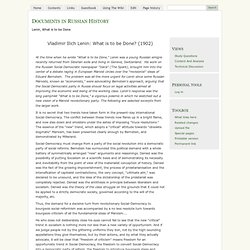
(1902) At the time when he wrote "What is to be Done," Lenin was a young Russian emigre recently returned from Siberian exile and living in Geneva, Switzerland. Archdukes, Cynicism, and World War I: Crash Course World History #36. The Battle Of Tannenberg (WWI) The Battle of Verdun.
WORLD WAR ONE TRENCH WARFARE. The failure of the Schlieffen Plan. World War I, The Schlieffen Plan. Count Alfred von Schlieffen, who became Chief of the Great General Staff in 1891, submitted his plan in 1905; it was adopted, slightly modified, in 1914.
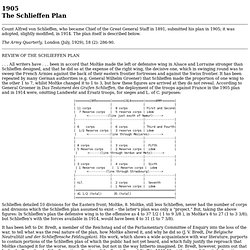
The plan itself is described below. The Army Quarterly, London (July, 1929), 18 (2): 286-90. . . . All writers have . . . been in accord that Moltke made the left or defensive wing in Alsace and Lorraine stronger than Schlieffen designed, and that he did so at the expense of the right wing, the decisive one, which in swinging round was to sweep the French Armies against the back of their eastern frontier fortresses and against the Swiss frontier.
It has been repeated by many German authorities (e.g. Schlieffen detailed 10 divisions for the Eastern front; Moltke, 8. It has been left to Dr. Was There a Schlieffen Plan? Steven Cromack In a 1999 journal article published in War in History, historian Terence Zuber dropped a bombshell on the academic community.
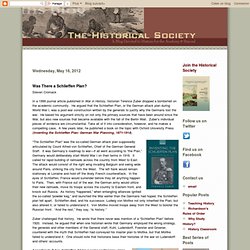
He argued that the Schlieffen Plan, or the German attack plan during World War I, was a post-war construction written by the generals to justify why the Germans lost the war. He based his argument strictly on not only the primary sources that have been around since the War, but also new sources that became available with the fall of the Berlin Wall.
Zuber’s individual pieces of evidence are circumstantial. Take all of it into consideration, however, and he makes a compelling case. Internet History Sourcebooks. World War I See Main Page for a guide to all contents of all sections.

Contents. A Guide to World War I Materials (Virtual Programs & Services, Library of Congress) Compiled by Kenneth Drexler, Digital Reference Specialist The digital collections of the Library of Congress contain a wide variety of material related to World War I, including photographs, documents, newspapers, films, sheet music, and sound recordings.
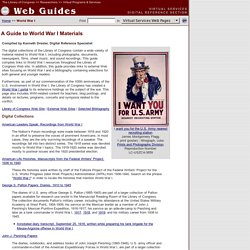
This guide compiles links to World War I resources throughout the Library of Congress Web site. In addition, this guide provides links to external Web sites focusing on World War I and a bibliography containing selections for both general and younger readers. Furthermore, as part of our commemoration of the 100th anniversary of the U.S. involvement in World War I, the Library of Congress has created a World War I portal to its extensive holdings on the subject of the war. This page also includes WWI-related content for teachers, blog postings, and details on lectures, programs, concerts and symposia related to the conflict. Library of Congress Web Site | External Web Sites | Selected Bibliography George S. John J. Patriotic Melodies. WW1 Battlefields of the Western Front.
The long line of battlefields that makes up the Western Front runs through a wide variety of landscapes in south-west Belgium, north-eastern and eastern France.

A guide to the WW1 battlefields and home to the Poppy Umbrella. The Great War . Timeline . Pre-1914. History - World Wars: Animated Map: The Western Front, 1914 - 1918. World War I, 1917. Detailed Timeline of European History Great War/World War I (1914 - 1919) A New Terrible Type of Warfare, New Nations Created in Europe Go to European History Interactive Map. Consequences of WW1 Diagram #historyteacher. How it Began. If you are new to the First World War - or are rusty after many years since history class - the reasons for the so-called 'Great War' can be shrouded in confusion. The Second World War was rather more straightforward: no questions there who did what and who was at fault. This website contains much material based in and around the events of World War One - but if you are unsure how it began and who did what, well, where to begin?
Profile of Otto von Bismarck Video. Otto Van Bismarck is an essential historical figure in the creation of the German Empire. Watch this About.com video to learn how Otto von Bismark rose to power and about the legacy he left.See Transcript Hi I’m Jade and today with About.com we are going to discuss the life of Otto van Bismarck. Otto Van Bismarck rose to the rank of Imperial Chancellor, led Prussia through 3 wars, and through a series of aggressive political maneuvers united the German Empire. Bismark's Early LIfe Much of Bismarck’s early life was unremarkable.
Otto Van Bismark's Rise to Power Bismarck moved up though a series of positions serving in both national and foreign posts. The Austro-Hungarian Ultimatum to Serbia (English translation) From World War I Document Archive WWI Document Archive > Official Papers > The Austro-Hungarian Ultimatum to Serbia (English translation)